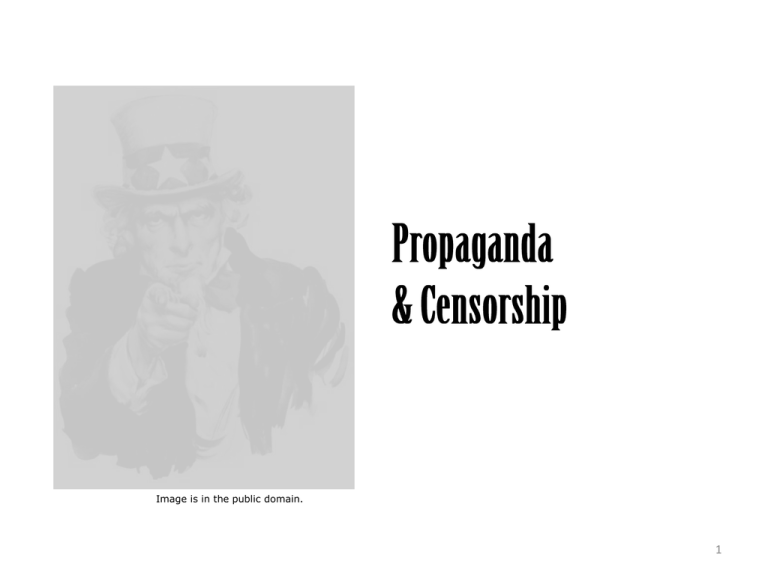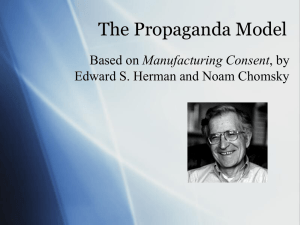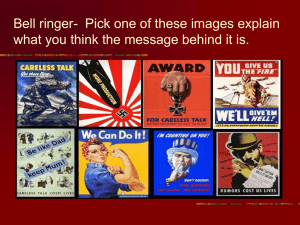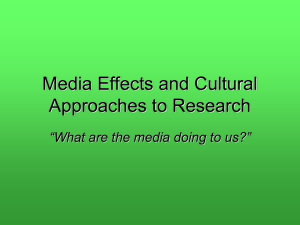
Image is in the public domain.
1
Image is in the public domain.
“Set of methods employed by an organized group that
wants to bring about the active or passive
participation in its actions of a mass of individuals,
psychologically unified through psychological
manipulations and incorporated in an organization.”
(Jacques Ellul, 1973)
2
Image is in the public domain.
Progaganda: “deliberate and systematic attempt to shape
perceptions, manipulate cognitions, and direct behavior to
achieve a response that furthers the desired intent of the
propagandist.”
Persuasion: “interactive attempt to satisfy the needs of both
persuader and persuadee.”
(Jowett and O’Donnell, 2011)
3
Image is in the public domain.
Progaganda: intentional actions and conscious efforts to
change peoples’ ideas and behaviors.
Ideology: set of values, meanings and ideas that
unconsciously influence the choices of producers,
gatekeepers and journalists, as well as the interpretations
of the viewers.
4
Image is in the public domain.
People from all horizons can use propaganda techniques
to defend a cause that they consider noble.
5
Image is in the public domain.
People from all horizons are affected by propaganda
to varying degrees.
6
Image is in the public domain.
7
1) Becoming a source of information (creating news events,
press releases, press kits, talk show apperances, books,
posters, badges, slogans, advertisements, etc.).
2) Excluding undesirable sources of information by shaping
media policies or imposing censorships (direct, indirect,
political, moral, commercial).
3) Media concentration, centralization, globalization.
Ref. Patrick, 2013, p. 29-45
8
Image is in the public domain.
9
Creating the illusion of democracy, participation and
consensus (polling, surveys, marchings, crowds, mass
spectacles, slogans, uniforms, etc.) and inviting people
to join those on the road to victory, in order to provoke
a contagion effect.
10
American politicians
Courtesy of EL Gringo on flickr. Used with permission. License CC-BY-NC-SA.
11
Appealing to the people’s values, common
knowledge and stereotypes or making them
believe that they are threatened.
12
Using generalities to describe complex phenomena
while masking nuances and differences (stories, myths,
parables, stereotypes, anecdotes, slogans, visuals,
graphics, etc.).
Reinforcing oppositions (good/evil, rich/poor,
black/white, liberal/conservative, west/east,
terrorism/civilization, men/women,
capitalist/communist, etc.).
13
Entrance of Auschwitz-Birkenau
concentration camp
Courtesy of Chris Brown on flickr. Used with permission. License CC-BY.
14
Twisting the facts in favour of the propagandist without
directly lying. Embellishing or aggravating reality by
showing only one aspect of it or by presenting it from a
certain angle.
15
Replacing an expression by another to empty its
meaning or emotional charge. Using euphemisms such
as negative growth, market correction, re-deployment,
reorganization, collateral damage, etc. or dysphemisms
such as clan, insurgents, person of interest, etc.
16
Making sure that a message is noticed and retained by
using attractive elements (sex, stricking symbols,
humor, graphics, etc.), novelty (controversies,
conspiracy theories, revelations, forbidden elements,
buzzwords, trends, etc.) and by repeating it (branding,
acronyms, slogan etc.).
17
Disguising propaganda as news, talk shows, educative
films, documentaries, scientific reports, government
leaks, blogs, etc.
Using front organizations such as university research
groups or charity organizations in order to gain
legitimacy.
18
Evoking the people’s corporal needs (food, sex, shelter,
etc.), psychological needs (economic programs, lower
taxes, better neighbourhoods, etc.) or social needs
(ready-made identities, patriotism, etc.) or making
them believe that they are threatened.
19
Transforming a person into a symbol to make him/her
seem virtuous, praiseworthy, admirable or crazy, evil,
criminal, violent, greedy, etc. (Lincoln, Hitler, Tojo,
Luther King, Hussein, Bin Laden, etc.).
20
© TIME. All rights reserved. This content is excluded from our Creative Commons
license. For more information, see http://ocw.mit.edu/help/faq-fair-use/.
21
Transforming people into animals or objects (vermin,
machines, monsters, vultures, pigs, etc.) to make them
less likeable and devalue their life.
22
Quoting or showing celebrities, experts, consultants,
respected public figures or prestigious institutions to
support a position and gain credibility.
Showing evidences (statistics, facts, data, surveys,
reports, logical arguments, scientific findings, economic
indices, etc.).
23
Omitting information that contradicts the
propagandist’s ideas, cause or regime.
24
Forcing relations between things, ideas, people or
groups, by juxtaposing several images, images and
texts, images and narration, etc.
25
Introducing false information, rumors and lies.
26
Appropriating myths, cultural referents, collective
fears, hopes or resentment, in order to serve the
propagandist cause.
27
Creating emotions and touch people’s heart instead
of stimulating reasoning and critical thinking.
28
Image is in the public domain.
29
Image is in the public domain.
Victims of the enemy states benefit from more
sensitive media coverage than victims of the United
States and its allies (use of words such as ‘genocide’,
‘massacre’, etc.).
Ref. Herman & Chomsky, 2002
30
Image is in the public domain.
Foreign elections that are not supported by the US
government are depicted as ‘sham’, ‘rigged’, ‘fraudulent’,
‘imperfect’, and elections that are supported by the US
government are depicted as ‘encouraging’, ‘a step toward
democracy’, ‘remarkable achievement’ while flaws and
frauds are ignored.
Ref. Herman & Chomsky, 2002
31
Image is in the public domain.
When the United States are at war, American media:
• highlight the noble intentions of the US government (protecting the
people)
• avoid using terms such as ‘aggression’ to describe the US intervention
• fail to report illegal actions (chemical attacks, policy of starvation, etc.)
• avoid questioning the government right to intervene
• while demonizing the victims (focusing on US army casualties and war
prisoners).
Ref. Herman & Chomsky, 2002
32
Image is in the public domain.
American media are ignoring dictators that are
instrumental to the US government, while demonizing
dictators that are not useful to the US government (use
of words such as ‘killer’, ‘war criminal’, ‘mass
murderer’, ‘dictator’, etc.).
Ref. Herman & Chomsky, 2002
33
Image is in the public domain.
When it comes to national politics, American media are
limiting the debates to the terms defined by the two
main political parties and excluding issues that these
parties agree on (unions, large defense budget, trade
agreements, use of chemical, etc.).
Ref. Herman & Chomsky, 2002
34
Image is in the public domain.
For local issues, media are ignoring polls that show
opposition to issues on which major investors in political
parties agree. Media coverage is often hostile to protesters
(use of words such as ‘all-purpose agitators’,
‘troublemakers’), while downplaying the police provocation
and violence (use of chemical weapons and rubber bullets).
Ref. Herman & Chomsky, 2002
35
Image is in the public domain.
Mass media propagandize on behalf of the social
interests that control and finance them.
Ref. Herman & Chomsky, 2002
36
Image is in the public domain.
37
38
Domenach, Jean-Marie. 1992. La propagande politique. Paris: PUF.
Herman, Edward S. and Noam Chomsky. 2002. Manufacturing Consent. New
York: Pantheon Books.
Patrick, Brian Anse. 2013. The Ten Commandments of Propaganda. London:
Arktos.
Roland, Jon. 1998. “Propaganda Technique”. Constitution Society. Website:
http://www.constitution.org/col/propaganda_army.htm.
Tchakhotine, Serge. 1992. Le viol des foules par la propagande politique. Paris:
Gallimard.
39
Examples of propaganda:
•
•
•
•
•
Triumph of the Will
Animated Soviet Propaganda
Why We Fight
The Eternal Jew
L’oeil de Vichy
40
MIT OpenCourseWare
http://ocw.mit.edu
CMS.701 / CMS.901 Current Debates in Media
Spring 2015
For information about citing these materials or our Terms of Use, visit: http://ocw.mit.edu/terms.






